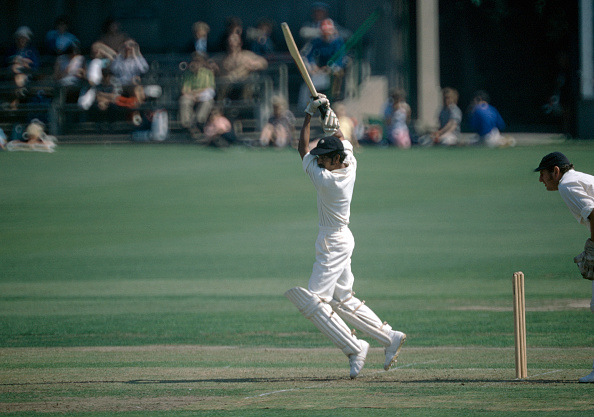
SK Flashback: Before Jonty Rhodes, there was Eknath Solkar

Even in an age of helmets, shin pads and abdomen guards, standing at short leg remains a risky affair. Freak injuries are not unheard of in cricket, and short leg, quite reasonably, remains a vulnerable position.
The fact that the junior-most members of a team are frequently told to stand at short leg indicates the reluctance of cricketers to put their lives and careers at stake for a catch or two.
Every once in a while – or more honestly, a lifetime – however, there comes a braveheart who embraces this danger and volunteers to stand at short leg. Rewind four and a half decades – India, too, had their braveheart. On this day in 1948, Eknath Dhondu Solkar was born.
A fielder par excellence
Solkar had a curious penchant for excelling at close-in positions. In the course of his brief career, he would not only make the short leg position his own, but also manage to take quite a few blinders at that position. Fear was, as if, merely an insignificant word in his dictionary.
His impossibly quick reflexes coupled with an awe-inspiring sense of anticipation made him a fielder who could not only create chances but also hold on to them. Dubbed as one of the best close-in fielders cricket has ever seen, Solkar was notorious in plucking the ball out of thin air.
Further, he expected the same standard of fielding from everyone around him. He was known to scream ‘catch it’ when full-blooded shots ricocheted off his body.

Solkar’s explanation for his fielding capabilities was a pretty ordinary one: “I only watch the ball.” In reality, however, a lot went into the kind of stunners he pulled off regularly at short leg. One of the best examples of his abilities dates back to the Oval Test in the 1971-72 tour of England.
Allan Knott was a fearsome batsman in the English line-up. It was only understandable that the Indians would look to have him back in the dressing room as early as possible. However, Knott was famous for his determination and the fact that he rarely erred while judging deliveries.
Finally, though, he misjudged the length off a Venkatraghvan delivery and the ball bounced a bit more than he anticipated before launching into the air. Ordinarily, the ball would have landed halfway between the batsman and the short leg fielder, and a collective ‘ooh’ would have signalled the fact that it was a half-chance. But Solkar was not an ordinary fielder. He foresaw the trajectory of the ball and within milliseconds, dived full length to catch it before it hit the ground.
The Indian bowling unit was essentially dominated by spinners during those years. Solkar, quite surprisingly, remains a forgotten name despite being a major reason behind the flourishing of his teammates like Bishen Singh Bedi.
Also read: 7 bravest close-in fielders in cricket history
He went on to pouch 53 catches in only 27 Tests and earned applause from the entire cricketing fraternity. Bedi, in fact, stated without hesitation that Indian spinners would never have been as effective without Solkar at short leg.
Even Ravi Shastri’s words stand testament to the quality of fielding Solkar practised. In a domestic match between Bombay and Saurashtra at Bhuj, Bombay’s Suru Nayak induced an under-edge from Naresh Parsana as the latter went for the pull. Shastri recalled how Solkar at short leg refused to take evasive action, and instead, managed to complete a spectacular catch inches from the ground.
Poor man’s Sobers
Solkar’s fielding was simply the tip of the iceberg, though, when it came to his value to the team. Although not particularly flamboyant, he was a decent batsman and possessed the unique ability to bowl seam as well as spin. He was so good that he came to be known as ‘poor man’s Sobers’.
A complete team player, he loved to contribute in every way possible whenever the team needed him to step up. In a team consisting of popular names, he was a grossly underrated player. According to Ajit Wadekar, “Ekki was the perfect team man. He was always ready to bat anywhere in the order and also started seam bowling despite being a spin bowler because we didn’t have opening bowlers.”

Interestingly, one incident that is spoken about whenever Solkar’s name comes up involves an altercation with Sir Garfield Sobers. When India toured West Indies in 1971, the home team’s line-up was enough to intimidate any opposition both psychologically and inside the 22 yards.
Also read: 5 cricketers whose USP was their fielding
With Dilip Sardesai and Solkar trying to spare the Indian team the blushes, Sobers noticed that the ball had lost its shape. As the officials called for a replacement, Solkar demanded to see the ball. “What’s the point? You will play and miss anyway,” Sobers said, to which the Indian replied, “You play your game, we will play ours.”
The 1974 Test against West Indies at the Wankhede Stadium witnessed the only century in Solkar’s career. He was stranded in the nineties for what seemed like forever, so much so that he was dropped from the team even after scoring a hundred.
Yet, his rearguard efforts and solid partnerships with more distinguished batsmen continue to be remembered fondly by those who have shared the dressing room with him.
In a tragic turn of incidents, Solkar suffered from a heart attack at the age of 57 and passed away on June 26, 2005.